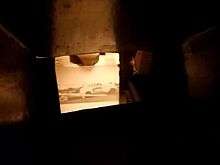Mutoscope
.jpg)



The Mutoscope was an early motion picture device, invented by Winsor McCay and later patented by Herman Casler on November 21, 1894.[1] Like Thomas Edison's Kinetoscope, it did not project on a screen and provided viewing to only one person at a time. Cheaper and simpler than the Kinetoscope, the system, marketed by the American Mutoscope Company (later the American Mutoscope and Biograph Company), quickly dominated the coin-in-the-slot peep-show business.
Operation
The Mutoscope worked on the same principle as the flip book. The individual image frames were conventional black-and-white, silver-based photographic prints on tough, flexible opaque cards. Rather than being bound into a booklet, the cards were attached to a circular core, rather like a huge Rolodex. A reel typically held about 850 cards, giving a viewing time of about a minute.[2] The reel with cards attached had a total diameter of about ten inches (25 cm); the individual cards had dimensions of about 2 3⁄4" x 1 7⁄8" (7 cm x 4.75 cm).
Mutoscopes were coin-operated. The patron viewed the cards through a single lens enclosed by a hood, similar to the viewing hood of a stereoscope. The cards were generally lit electrically, but the reel was driven by means of a geared-down hand crank. Each machine held only a single reel and was dedicated to the presentation of a single short subject, described by a poster affixed to the machine.
The patron could control the presentation speed only to a limited degree. The crank could be turned in both directions, but this did not reverse the playing of the reel. Nor could the patron extend viewing time by stopping the crank because the flexible images were bent into the proper viewing position by tension applied from forward cranking. Stopping the crank reduced the forward tension on the reels causing the reel to go backwards and the picture to move from the viewing position; a spring in the mechanism turned off the light and in some models brought down a shutter which completely blocked out the picture.
Manufacture
Mutoscopes were originally manufactured from 1895 to 1909 by the American Mutoscope and Biograph Company, or its licensee Marvin & Casler Co., formed by two of American Mutoscope's founders. In the 1920s the Mutoscope was licensed to William Rabkin who started his own company, the International Mutoscope Reel Company, which manufactured new reels and also machines from 1926 until 1949. The term "Mutoscope" is no longer a registered trademark in the United States.
Usage
Mutoscopes were a popular feature of amusement arcades and pleasure piers in the UK until the introduction of decimal coinage in 1971. The coin mechanisms were difficult to convert, and many machines were subsequently destroyed; some were exported to Denmark where pornography had recently been legalised. The typical arcade installation included multiple machines offering a mixture of fare. Both in the early days and during the revival, that mixture usually included "girlie" reels which ran the gamut from risqué to outright soft-core pornography. It was, however, common for these reels to have suggestive titles that implied more than the reel actually delivered. The title of one such reel, What the Butler Saw, became a by-word, and Mutoscopes are commonly known in the UK as "What-the-Butler-Saw machines." (What the butler saw, presumably through a keyhole, was a woman partially disrobing.)
Public response
In 1899, The Times printed a letter inveighing against "vicious demoralising picture shows in the penny-in-the-slot machines. It is hardly possible to exaggerate the corruption of the young that comes from exhibiting under a strong light, nude female figures represented as living and moving, going into and out of baths, sitting as artists' models etc. Similar exhibitions took place at Rhyl in the men's lavatory, but, owing to public denunciation, they have been stopped."
A collector's site describes the contents of one such reel, "Birth of the Pearl" which "pictures a nude woman rising from a seashell and standing." The site notes "this reel has some damage to a whole chunk of photos. They are all in a section where there was full frontal nudity and the cards are quite worn off."
Notes
- ↑ Spehr, Paul C. (2000). "Unaltered to Date: Developing 35mm Film," in Moving Images: From Edison to the Webcam, ed. John Fullerton and Astrid Söderbergh Widding, pp. 3–28 (p. 17). Sydney: John Libbey & Co.
- ↑ Mutoscopes & Reels, Gameroom Show.
External links
- Illustration and demonstration of the Kinora
- Penny Arcade, poem by Jared Carter describes tightrope-walk images viewed through a Mutoscope.
- Streible, Dan (Autumn 2003). "Children at the Mutoscope". Journal of Film Studies. Cinémas. 14 (1): 91–116. doi:10.7202/008959ar.
![]() Media related to Mutoscope at Wikimedia Commons
Media related to Mutoscope at Wikimedia Commons